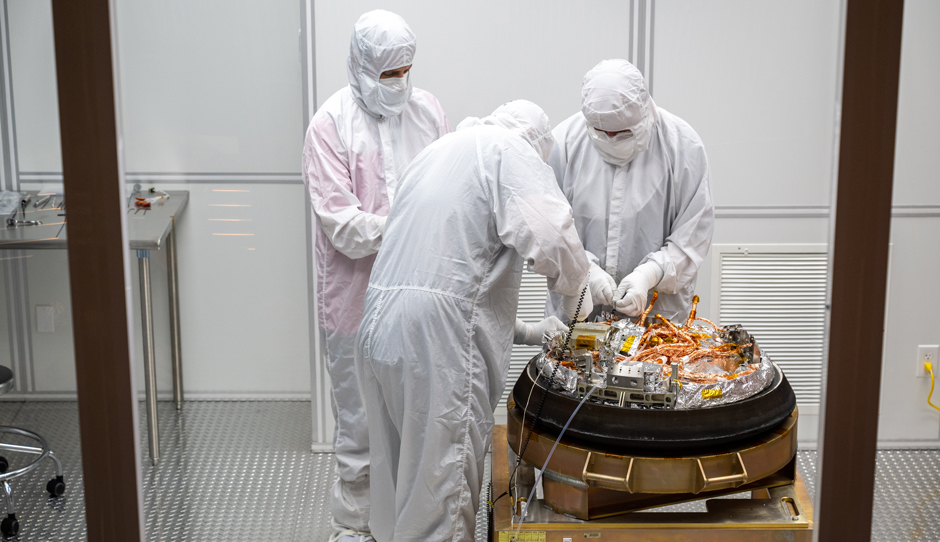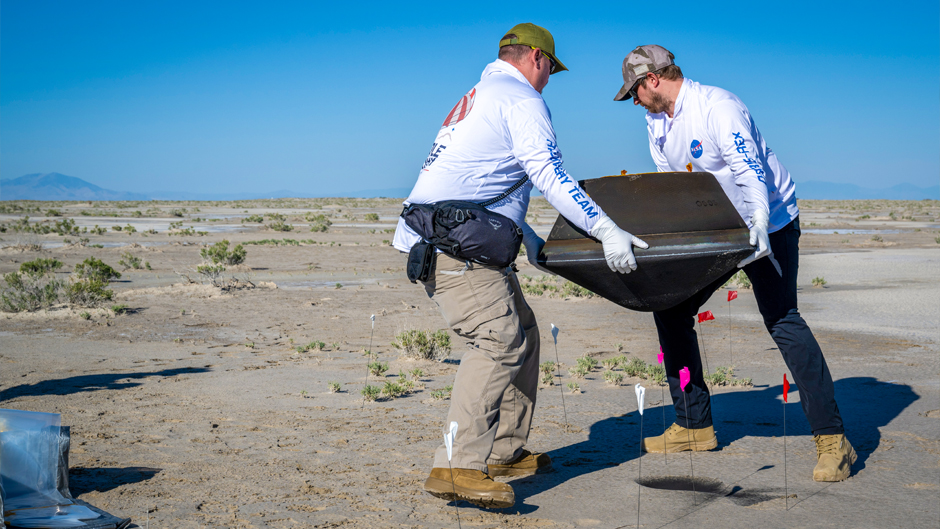For now, it’s the origin of life scientists have been seeking. And while the pieces of a primordial asteroid collected from a NASA spacecraft and brought to Earth this week may hold the clue, they may lead to a bigger, more ambitious mission.
Samples taken from the 4.5-billion-year-old Bennu asteroid could very well make it easier for astronauts to travel to and live on Mars and, perhaps, worlds beyond our solar system, according to a University of Miami Ph.D. student in astrophysics.
“Closely examining asteroids like Bennu provides crucial insights into the feasibility of asteroid mining during deep-space exploration and travel,” said Alessandro Peca, who watched Sunday’s livestream of a NASA capsule plunge to Earth with its precious cargo—about 250 grams of space rock—safely intact.

Scientists process the sample return capsule in a clean room at the Department of Defense's Utah Test and Training Range. Photo: Courtesy of NASA
“While rare metals often steal the spotlight, it’s water that emerges as a potentially game-changing resource within Bennu,” he said. “Water, composed of two hydrogen atoms bonded to an oxygen atom, possesses multifaceted utility—it can serve as a vital source for drinking, be separated into its constituent elements to produce breathable air, and be transformed into rocket fuel. Given the exorbitant costs associated with transporting materials into space, the ability of astronauts to extract water from an asteroid holds the promise of bringing the far reaches of the cosmos closer to human reach than ever before.”
For Peca, watching the capsule parachute onto the Utah Test Training Range after a nearly 4-billion-mile journey over the past seven years felt “like watching a captivating movie unfold,” he said.
“A journey into space, collecting precious material, and the subsequent in-depth scientific study,” he said. “I’m thrilled about the project’s potential not only to enhance our knowledge about asteroids but also to showcase our remarkable ability to explore and study the far reaches of space.”
Launched seven years ago, NASA’s OSIRIS-REx spacecraft reached Bennu in 2018, circling the near-Earth asteroid for about two years before using its robotic arm to gather the pieces of space rock.
The 20-foot-long OSIRIS-REx—which stands for Origins, Spectral Interpretation, Resource Identification, and Security-Regolith Explorer—then flew by Earth, jettisoning the capsule containing the samples from Bennu.
The samples are now in a “clean room” at NASA’s Johnson Space Center in Houston, where scientists will analyze some of the pieces over the next two years. “Some asteroids are debris of ancient planetary collisions, and some are the remnants of the primordial cloud from which the solar system originated,” explained Nico Cappelluti, an assistant professor of astrophysics in the College of Arts and Sciences. “We know that these clouds might contain organic molecules that are the building bricks of life as we know it. All the information that will be gleaned [from the Bennu samples] will constitute a new discovery.”
The mission is a first for NASA—and an inspiration for University of Miami College of Engineering students who designed and built a lunar mining robot as part of the space agency’s 2023 Lunabotics competition.
“Incredible engineering feats such as the OSIRIS-REx mission are inspiring because they demonstrate that anything is possible,” said aerospace engineering student Neyton Baltodano Jr. “Those of us who have worked on the lunar mining robot project are excited by the prospect that one day in our careers we’ll be working on cutting-edge space missions that push the limits of science and technology.”
The Bennu project is also a look at the future, according to Cappelluti. “This recent endeavor is just the precursor to the forthcoming return to Earth of Martian soil samples,” he said. “All of these projects will add a piece to the puzzle of our history.”

